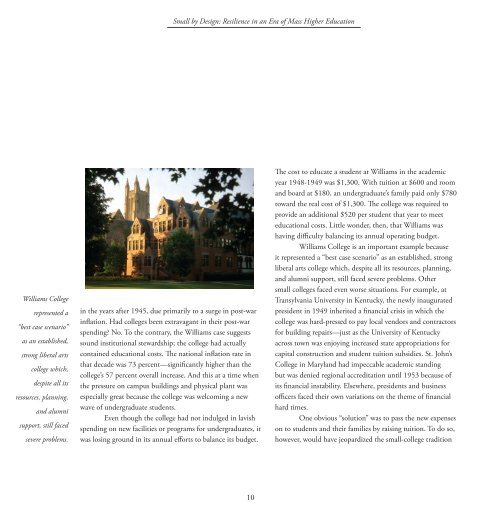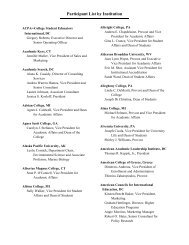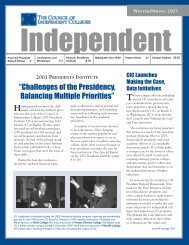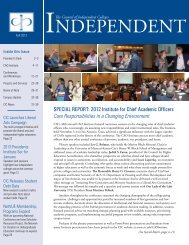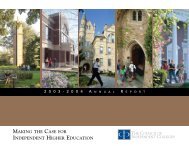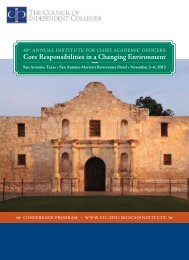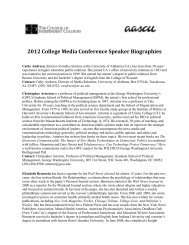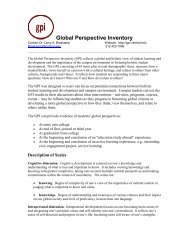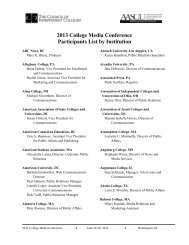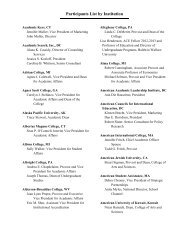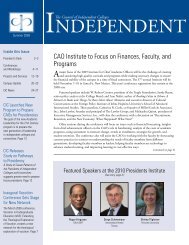Meeting the Challenge: - The Council of Independent Colleges
Meeting the Challenge: - The Council of Independent Colleges
Meeting the Challenge: - The Council of Independent Colleges
You also want an ePaper? Increase the reach of your titles
YUMPU automatically turns print PDFs into web optimized ePapers that Google loves.
Small by Design: Resilience in an Era <strong>of</strong> Mass Higher Education<br />
Williams College<br />
represented a<br />
“best case scenario”<br />
as an established,<br />
strong liberal arts<br />
college which,<br />
despite all its<br />
resources, planning,<br />
and alumni<br />
support, still faced<br />
severe problems.<br />
in <strong>the</strong> years after 1945, due primarily to a surge in post-war<br />
inflation. Had colleges been extravagant in <strong>the</strong>ir post-war<br />
spending No. To <strong>the</strong> contrary, <strong>the</strong> Williams case suggests<br />
sound institutional stewardship; <strong>the</strong> college had actually<br />
contained educational costs. <strong>The</strong> national inflation rate in<br />
that decade was 73 percent—significantly higher than <strong>the</strong><br />
college’s 57 percent overall increase. And this at a time when<br />
<strong>the</strong> pressure on campus buildings and physical plant was<br />
especially great because <strong>the</strong> college was welcoming a new<br />
wave <strong>of</strong> undergraduate students.<br />
Even though <strong>the</strong> college had not indulged in lavish<br />
spending on new facilities or programs for undergraduates, it<br />
was losing ground in its annual efforts to balance its budget.<br />
<strong>The</strong> cost to educate a student at Williams in <strong>the</strong> academic<br />
year 1948-1949 was $1,300. With tuition at $600 and room<br />
and board at $180, an undergraduate’s family paid only $780<br />
toward <strong>the</strong> real cost <strong>of</strong> $1,300. <strong>The</strong> college was required to<br />
provide an additional $520 per student that year to meet<br />
educational costs. Little wonder, <strong>the</strong>n, that Williams was<br />
having difficulty balancing its annual operating budget.<br />
Williams College is an important example because<br />
it represented a “best case scenario” as an established, strong<br />
liberal arts college which, despite all its resources, planning,<br />
and alumni support, still faced severe problems. O<strong>the</strong>r<br />
small colleges faced even worse situations. For example, at<br />
Transylvania University in Kentucky, <strong>the</strong> newly inaugurated<br />
president in 1949 inherited a financial crisis in which <strong>the</strong><br />
college was hard-pressed to pay local vendors and contractors<br />
for building repairs—just as <strong>the</strong> University <strong>of</strong> Kentucky<br />
across town was enjoying increased state appropriations for<br />
capital construction and student tuition subsidies. St. John’s<br />
College in Maryland had impeccable academic standing<br />
but was denied regional accreditation until 1953 because <strong>of</strong><br />
its financial instability. Elsewhere, presidents and business<br />
<strong>of</strong>ficers faced <strong>the</strong>ir own variations on <strong>the</strong> <strong>the</strong>me <strong>of</strong> financial<br />
hard times.<br />
One obvious “solution” was to pass <strong>the</strong> new expenses<br />
on to students and <strong>the</strong>ir families by raising tuition. To do so,<br />
however, would have jeopardized <strong>the</strong> small-college tradition<br />
10


